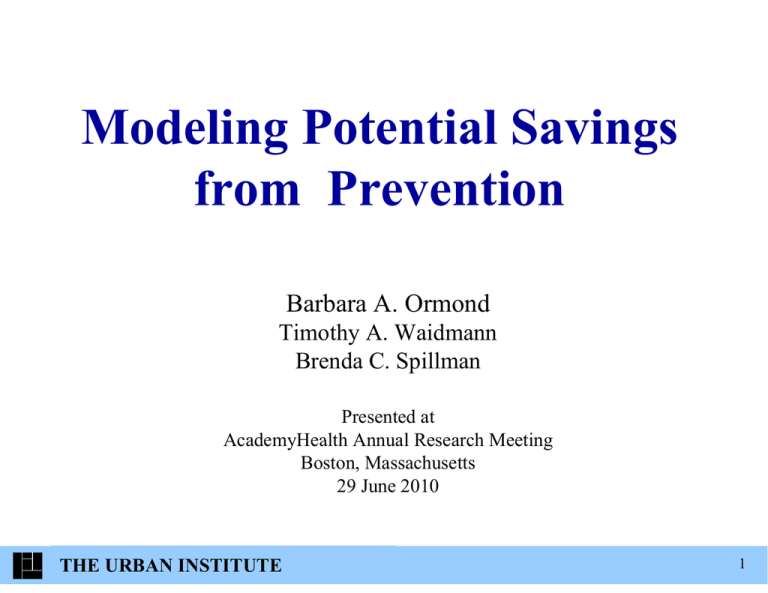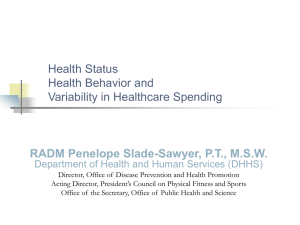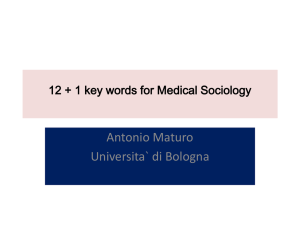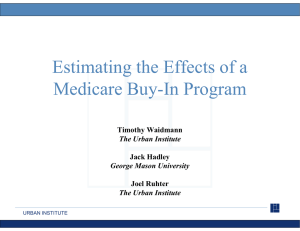Modeling Potential Savings g from Prevention B b
advertisement

Modelingg Potential Savings g from Prevention B b A. Barbara A O Ormond d Timothy A. Waidmann Brenda C. Spillman Presented at AcademyHealth Annual Research Meeting Boston, Massachusetts 29 June 2010 THE URBAN INSTITUTE 1 Research ese c questions ques o s • How much can the prevalence of selected preventable conditions be reduced thru community-based community based primary prevention? • Can suchh reductions C d ti be b sustained t i d over time ti andd across different population groups? • How much do people with these conditions spend on medical care? • If the prevalence of these conditions were reduced, how p could be saved? much of this expenditure • How would these savings be distributed across payers, over time time, and across states? THE URBAN INSTITUTE 2 Most expensive conditions 1. 2. 3 3. 4. 5 5. 6. 7. 8. Heart disease Cancer Trauma Mental disorders Pulmonary conditions Diabetes H Hypertension t i Cerebrovascular di disease 9. 10. 11 11. 12. 13. 14. 15 15. Arthritis Pneumonia Kidne disease Kidney Endocrine di d disorders Skin disorders Back problems Infectious diseases From Cohen and Krauss Krauss, Spending and service use among people with the 15 most costly medical conditions, Health Affairs 2003, 22(3):129-38 THE URBAN INSTITUTE 3 Disease clusters - intervention pathways p y short run ((uncomplicated p disease)) diabetes medium run ((complicated p disease)) heart disease stroke renal disease diabetes & HBP HBP THE URBAN INSTITUTE heart disease stroke t k renal disease 4 Estimation of the model • Data D t • Medical Expenditures Panel Survey (MEPS), pooled l d 2003-2005 2003 2005 (adults ( d l only, l excludes l d institutionalized population) • Methods M th d • Regression analysis to predict expenditures by disease cluster • Modeling of effects over time and across payors THE URBAN INSTITUTE 5 Estimation of excess medical costs E(Spi) = exp[ ∑γj Cji + XiB] THE URBAN INSTITUTE 6 State-level estimation • Creation of “pseudo-states” • Re Re-estimation estimation of excess medical costs • Calculation of potential savings by payer THE URBAN INSTITUTE 7 Excess annual medical expenditures all ll payers, 2008 dollars d ll spending ($billions) Short run modifiable conditions % of total $180 12.3 Diabetes 31 21 2.1 High blood pressure (HBP) 97 6.6 Diabetes & HBP 52 3.6 $314 21.6 Heart | renal | cerebrovascular disease (H | R | C) 76 5.2 Diabetes & H | R | C 34 2.3 120 8.2 85 58 5.8 $494 33.9 $ $1,457 100.0 Medium run modifiable conditions HBP & H | R | C Di b t & HBP & H | R | C Diabetes Total excess spending Total spending THE URBAN INSTITUTE 8 Excess annual medical spending b payer, 2008 dollars by d ll Medicaid Medicare All Other Payers spending ($billions) % of total spending ($billions) % of total spending ($billions) % of total $15 86 8.6 $30 90 9.0 $134 13 8 13.8 Diabetes 3 1.7 7 2.0 21 2.2 High blood pressure (HBP) 5 3.0 15 4.6 76 7.7 Diabetes & HBP 7 3.8 8 2.4 37 3.9 $32 17.6 $124 37.1 $158 17.5 H|R|C 5 28 2.8 27 79 7.9 44 47 4.7 Diabetes & H | R | C 5 2.9 19 5.6 10 1.3 HBP & H | R | C 9 5.1 44 13.3 66 7.1 12 6.8 35 10.3 38 4.4 $47 26.2 $155 46.2 $292 31.3 $181 100 0 100.0 $335 100 0 100.0 $941 100 0 100.0 Short run modifiable conditions Medium run modifiable conditions Diabetes & HBP & H | R | C Total Excess Spending Total Spending THE URBAN INSTITUTE 9 Excess annual medical spending b payer, 2008 dollars by d ll All Payers y Spending ($billions) Medicaid % of all payer total Short run Diabetes HBP Diabetes & HBP $180 31 97 9 52 8.6% 10.2% 5.7% 5 % 13.2% 16.8% 21.7% 16.0% 6 0% 15.5% 74.6% 68.1% 78.4% 8 % 71.3% Medium run H|R|C Diabetes & (H | R | C) HBP & (H | R | C) Diabetes & HBP & (H | R | $314 76 34 120 85 10.2% 6.7% 15.8% 7 7% 7.7% 14.5% 39.6% 35.0% 55.8% 37 1% 37.1% 40.6% 50.3% 58.3% 28.4% 55 2% 55.2% 44.9% Total Excess Spending $494 9 6% 9.6% 31 3% 31.3% 59 1% 59.1% THE URBAN INSTITUTE Medicare All Other Payers y % of % of all payer total all payer total 10 Estimated Potential Savings from illustrative 5% prevalence reduction • National annual savings • • $9 billion from preventing uncomplicated disease in short run $24.7 billion reduction in complications in medium run • Largest states have greatest potential $ savings • CA, NY, FL, TX, and PA • Greatest potential % savings are in states with high disease burdens • WV MS, WV, MS AL, AL AR AR, and TN THE URBAN INSTITUTE 11 Discussion • The estimated $9 billion national savings in the model’s first period would cover an investment of $29 for everyy US resident. • Second period savings would increase threefold although the timing of such returns is fold, uncertain. • • The distribution of potential savings by age and payer suggests that community-level prevention ti could ld serve as a vehicle hi l for f reduction of health disparities. THE URBAN INSTITUTE 12 Thank you. Barbara A. Ormond, Brenda C. Spillman, Timothy A. Waidmann, Kyle J C J. Caswell, ll andd Bogdan B d Tereshchenko, T h h k Potential P t ti l National N ti l andd State Health Care Savings from Primary Prevention, American Journal of Public Health, forthcoming. THE URBAN INSTITUTE 13 Limitations and assumptions • • • • • • There is limited data on the scalability of the interventions or the sustainability of the effects. Hence, we have assumed a one-time effect of interventions sustained over time. We have not yet modeled severity and differences in cost at different periods in disease and treatment process. The model calculates savings from reductions in prevalence not from reductions in severity. severity Savings are presented in 2008 dollars for both time periods. MEPS relies on self reports for diagnoses so some people may have been misclassified into disease clusters. The statistical rather than direct estimation of state effects is a source of possible error. Comparisons to state level findings from other research and to reported Medicaid costs of chronic disease (e.g., from CDC) provide external validity tests. The literature on the effects of community based prevention is diverse. diverse Interventions differ widely as do reported measures of their effects. Studies do not provide results over a long enough time or represent diverse enough populations to allow good judgments about the duration of effects or their broad applicability. Costs associated with interventions are rarely reported. reported Overall, Overall while our reading of the literature suggests that a 5% reduction in uncomplicated diabetes and hypertension can be achieved and sustained, the direct evidence for the efficacy of this type of intervention is still being collected and is not yet as strong as we would ld like. lik THE URBAN INSTITUTE 14


